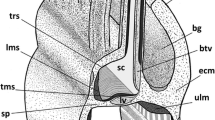Summary
The pigmentary system of the planaria, Dugesia gonocephala s.l. (Platyhelminthes, Turbellaria, Tricladida), has been studied by light and electron microscopy. The system consists of granules contained in chromatophore-like cells embedded in the parenchyma. The cell processes penetrate between the muscle layers and extend to the sub-epidermal basal lamina. The nature of the pigment and the comparative anatomical significance of the chromatophore structure is discussed.
Similar content being viewed by others
References
Bagnara, J.T., Hadley, M.E.: Chromatophores and color change; the comparative physiology of animal pigmentation. New Jersey: Prentice-Hall Inc., Englewood Cliffs 1973
Cloudsley-Thompson, J.L.: Pigments and chromatophore reactions of Polycelis nigra and Planaria lugubris. Nature 156, 294–295 (1945)
De Beauchamp, P.: Classe des Turbellariés. In: Traité de Zoologie (P.P. Grassé, ed.). Tome IV/I, pp. 35–212. Paris: Masson et C. 1961
Drochmans, P.: Melanin granules: their fine structure, formation, and degradation in normal and pathological tissues. Int. Rev. Exp. Path. 2, 357–422 (1963)
Elofsson, R., Hallberg, E.: Correlation of ultrastructure and chemical composition of crustacean chromatophore pigment. J. Ultrastruct. Res. 44, 421–429 (1973)
Ganter, P., Joliès, G. Histochimie normale et pathologique. Paris: Gauthier-Villars 1969–1970
Gremigni, V., Domenici, L.: Electron microscopical and cytochemical study of vitelline cells in the fresh water Triclad Dugesia lugubris s.l. I. Origin and morphogenesis of cocoon-shell globules. Cell Tissue Res. 150, 261–270 (1974)
Hyman, L.H.: The Invertebrates — Platyhelminthes and Rhynchocoela. Vol. 2, pp. 52–434. New York: McGraw-Hill 1951
Lison, L.: Histochimie et cytochimie animales. Paris: Gauthier-Villars 1960
Pinamonti, S.: Investigations of tryptophan metabolism via kynurenine in Dugesia gonocephala (Turbellaria, Tricladida, Paludicola). Boll. Zool. 40, 213–215 (1973)
Robison, W.G. Jr., Charlton, J.S.: Microtubules, microfilaments, and pigment movement in the chromatophores of Palaemonetes vulgaris (Crustacea). J. Exp. Zool. 186, 279–304 (1973)
Skaer, R.J.: The origin and continuous replacement of epidermal cells in the planarian Polycelis tenuis (Iijima). J. Embryol. Exp. Morph. 13, 129–139 (1965)
Valembois, P.: Infrastructure des cellules pigmentaires des Lombriciens et étude de leur rôle dans les hétérogreffes de paroi du corps. C.R. Acad. Sc., Paris, Série D, 265, 362–364 (1967)
Zelickson, A.S.: Melanocyte, melanin granule, and Langerhans cell. In: Ultrastructure of normal and abnormal skin. (A.S. Zelickson ed.), pp. 163–182. Philadelphia: Lea & Febiger 1967
Author information
Authors and Affiliations
Additional information
The authors wish to thank Prof. Beniamino Guidetti, Istituto di Neurochirurgia, University of Rome, for generous loan of freeze-drying equipment and Prof. Alessandro Polleri, Istituto Scientifico di Medicina Interna, University of Genoa, for critically reviewing the manuscript
Rights and permissions
About this article
Cite this article
Palladini, G., Medolago-Albani, L., Margotta, V. et al. The pigmentary system of planaria. Cell Tissue Res. 199, 197–202 (1979). https://doi.org/10.1007/BF00236131
Accepted:
Issue Date:
DOI: https://doi.org/10.1007/BF00236131




